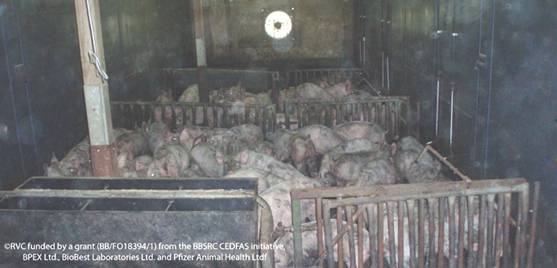Predisposing factors
As mentioned before many factors can influence the presence and potential severity of PMWS. The predisposing factors fall into two main groups:
- Presence of other pathogens on the farm (for example PRRS virus, Mycoplasma hyopneumoniae, Porcine Parvovirus and Swine Influenza virus);
- Factors related to management and biosecurity practices (for example overstocking, herd size, mixing in post weaning facilities, cross-fostering, disposal of sick pen waste, buying in gilts/boars from other farms).
There is some correlation between these two groups: presence of various pathogens can indicate general health status and management of the farm. Farms with weak biosecurity practices, and modest quality of immunization and preventive measures tend to have poor health. For example, a study in France found that farms that do not treat sows against external parasites are more likely to be PMWS positive. In England farms positive for Mycoplasma hyopneumoniae are more likely to be highly affected with PMWS, and farms were also more affected when the effluent from sick pens passed close to other areas holding pigs.
The location of the farm can be a predisposing factor; farms located in an area with a high density of pig farms have a higher risk of being infected. In Denmark, for example these farms are two times more likely to be PMWS positive.
However once the farm has got PMWS, the severity can vary from unapparent disease down to severe fatal disease. Factors leading to stress (e.g. abrupt temperature changes, poor ventilation) and increased infection pressure (e.g. overstocking) may predispose to high severity of PMWS. Avoiding these factors is the basis for controlling PMWS (see next unit: 'Alternative strategies for managing PRRS and PMWS')
If you want to get an estimate on how severely affected a farm is by PMWS, the link below takes you to a PMWS severity calculator.
http://dl.dropbox.com/u/40029445/PRRS_PMWS/PMWS_severity_estimation.xlsx
Source: Alarcon, P., et al, 2011, Assessment and quantification of post-weaning multi-systemic wasting syndrome severity at farm level. Preventive Veterinary Medicine 98, 19-28 (Supplementary data).
Stocking density is an important factor determining the severity of herd infection. Farms having high stocking densities tend to have more problems with PMWS, and by contrast, farms that keep their pigs (mainly growers) in low stocking density pens (more than 1m2/pig) are less affected.

Pens with high stocking density and poor ventilation. Additionally, direct contact of pigs between pens is possible.
Some pig breeds might be more susceptible to developing PMWS than others. Landrace pigs have been found to be more susceptible to PMWS, and show PCV-2 associated lesions more readily; while Durocs seem to be less susceptible. In addition, it seems that the male line is more influential. However more studies need to be carried out in order to have clearer evidence; until then, predisposing factors related to biosecurity and husbandry practices should have more weight when developing control programs than genetics alone.
Within infected farms some pigs can be affected by clinical signs and others will not be affected even when they are kept in the same pen. Why is that? Possible reasons are differences in maternal immunity and the age at which the infection developed.
When piglets are born, their immune system is not fully functional yet. Maternal immunity is defined as the antibodies that are passed from the sow to the piglets via colostrum, helping the piglets to fight pathogens they might encounter during the first few weeks of their life. Therefore effective maternal immunity is extremely important to protect piglets against diseases.
Piglets that are born to sows that do not have antibodies against PCV-2 are more likely to exhibit PMWS. Sows showing high viremia (i.e. virus circulating in blood) around farrowing and early PCV-2 infection (piglets less than 7 weeks) was suggested to significantly increase the risk of PMWS. These factors contribute to the called 'sow effect'
Environmental stressors such as temperature and farming practices (for example rearing sows in individual pens during pregnancy or early weaning) play an important role on the development of the disease; similarly piglets are more likely to exhibit PMWS if they are weaned early (before 21 days).
To summarize, list the main predisposing factors for PMWS
Considering the last two units ('PRRS - causes and predisposing factors' and 'PMWS - causes and predisposing factors':
Can you think of possible control measures for each disease?
Do you think some of these measures would help tackle both diseases?
The next unit will explore alternative strategies for managing PRRS and PMWS using current knowledge on both diseases and experiences accumulated over the past 20 years.